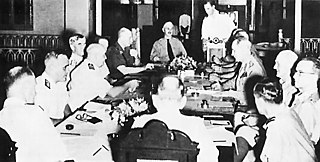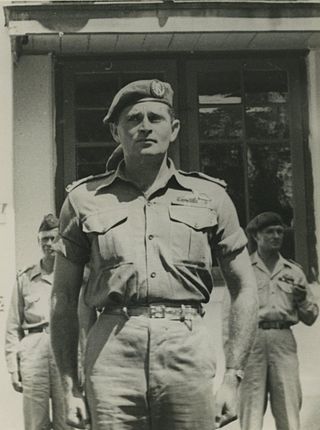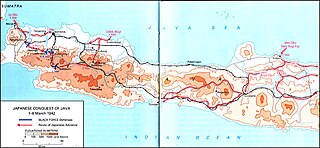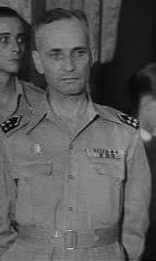
Hubertus Johannes "Huib" van Mook was a Dutch administrator in the East Indies. During the Indonesian National Revolution, he served as the lieutenant governor-general of the Dutch East Indies from 1942 to 1948. Van Mook also had a son named Cornelius van Mook who studied marine engineering at the Massachusetts Institute of Technology. He also wrote about Java - and his work on Kota Gede is a good example of a colonial bureaucrat capable of examining and writing about local folklore.

The American-British-Dutch-Australian (ABDA) Command, or ABDACOM, was the short-lived supreme command for all Allied forces in South East Asia in early 1942, during the Pacific War in World War II. The command consisted of the forces of Australia, the Netherlands, United Kingdom and the United States. The main objective of the command, led by General Sir Archibald Wavell, was to maintain control of the "Malay Barrier", a notional line running down the Malay Peninsula, through Singapore and the southernmost islands of the Dutch East Indies. ABDACOM was also known in British military circles as the "South West Pacific Command", although it should not be confused with the later South West Pacific Area command.

Hein ter Poorten was a Dutch military officer. He was the commander of the Royal Netherlands East Indies Army in World War II. Ter Poorten was also Allied land forces commander in the American-British-Dutch-Australian Command on Java during early 1942.

Lieutenant General Gerardus Johannes Berenschot was Commander-in-Chief of the Koninklijk Nederlands Indisch Leger. An Indo – as Eurasians of Indonesian and Dutch descent – Berenschot was the son of a Dutch officer in the KNIL.

The Royal Netherlands East Indies Army was the military force maintained by the Kingdom of the Netherlands in its colony of the Dutch East Indies, in areas that are now part of Indonesia. The KNIL's air arm was the Royal Netherlands East Indies Army Air Force. Elements of the Royal Netherlands Navy and Government Navy were also stationed in the Netherlands East Indies.

Joannes Benedictus "Jo" van Heutsz was a Dutch military officer who was appointed governor general of the Dutch East Indies in 1904, years after he had become famous for bringing to an end to the long Aceh War.

Raymond Pierre Paul Westerling was a Dutch military officer of the Royal Netherlands East Indies Army. He orchestrated a counter-guerrilla operation in Sulawesi during the Indonesian National Revolution after World War II and participated in a coup attempt against the Government of Indonesia in January 1950, a month after the official transfer of sovereignty. Both actions were denounced as war crimes by the Indonesian authorities. Born in the Ottoman Empire, despite his nickname, The Turk, Westerling was of mixed Dutch and Greek descent.

The Battle of Java was a battle of the Pacific theatre of World War II. It occurred on the island of Java from 28 February – 12 March 1942. It involved forces from the Empire of Japan, which invaded on 28 February 1942, and Allied personnel. Allied commanders signed a formal surrender at Japanese headquarters at Bandung on 12 March.

Operation Kraai was a Dutch military offensive against the de facto Republic of Indonesia in December 1948, following the failure of negotiations. With the advantage of surprise, the Dutch managed to capture the Indonesian Republic's temporary capital, Yogyakarta, and seized Indonesian leaders such as de facto Republican President Sukarno. This apparent military success was, however, followed by guerrilla warfare, while the violation of the Renville Agreement ceasefire diplomatically isolated the Dutch. This led to the Dutch–Indonesian Round Table Conference and recognition of the United States of Indonesia.

Korps Speciale Troepen was a Royal Netherlands East Indies Army (KNIL) special forces unit that was established for deployment against the Indonesian revolutionaries during the Indonesian National Revolution. It was formed in 1948 with the Depot Speciale Troepen at its core and disbanded alongside the Royal Netherlands East Indies Army in 1950, by which time it had been renamed to the Regiment Speciale Troepen. The DST consisted of about 570 men at its establishment in 1945 and had a precursor in the Korps Insulinde that conducted clandestine operations during the Japanese occupation of the Dutch East Indies. In June 1949, 250 men of the 1st Parachute Company were integrated into the Corps. The KST, which would reach a maximum strength of 1250 men, was composed of Dutch war volunteers (OVWs), Eurasians and native soldiers, including Moluccans. The present day Korps Commandotroepen of the Royal Netherlands Army is considered a continuation of the RST.

Alexander Evert Kawilarang was an Indonesian freedom fighter, military commander, and founder of Kesko TT, which would become the Indonesian special forces unit Kopassus. However, in 1958 he resigned his post as military attaché to the United States to join the rebel Permesta movement where he encountered Kopassus as his opponent. His involvement in Permesta damaged his military career, but he remained popular and active in the armed forces community.

Sultan Hamid II was the 7th Sultan of Pontianak and the only President of the State of West Kalimantan from 1946 to its disestablishment in 1950. He was the eldest son of Sultan Syarif Muhammad Alkadrie. He was of mixed Malay-Arab ancestry and was raised by two British nationals — Salome Catherine Fox and Edith Maud Curteis.

The APRA coup d'état was a coup d'état by Raymond Westerling's Legion of the Just Ruler (APRA) to capture Bandung and Jakarta, with the aim to overthrow Sukarno's unitary Republic of Indonesia. Westerling was a demobilised Dutch Captain of the KNIL, who sought to preserve the federal Republic of the United States of Indonesia, which retained the support of the Netherlands and various minority elements. Westerling's forces succeeded in capturing Bandung in the early hours of 23 January 1950.
Jhr. Johan Cornelis van der Wijck was a Dutch lieutenant general of the Royal Netherlands East Indies Army (KNIL) and governor of Aceh and related territories.

The Netherlands Indies Civil Administration was a semi-military organisation, established in April 1944, tasked with the restoration of civil administration and law of Dutch colonial rule after the capitulation of the Japanese occupational forces in the Dutch East Indies at the end of World War II.

Major-general Ludolph Hendrik van Oyen was the Chief of Staff of the Royal Netherlands East Indies Army from 1942 to 1946, during World War II.

Major general Dirk Reinhard Adelbert van Langen was a member of the chief of staff of the Royal Netherlands East Indies Army (KNIL), the territorial commander of East Java, and commander of the T-Brigade of the Royal Netherlands Army from 1946 to 1949, during the Indonesian National Revolution.

The Colonial Reserve Corps was an arm of the Royal Netherlands East Indies Army and an important recruitment depot. The Corps existed from 1890 to 1951 and was located in the Prins Hendrikbarracks in Nijmegen.

The 1st Infantry Battalion of the Royal Netherlands East Indies Army was a Dutch colonial military unit that was active in the Dutch East Indies during World War II and the Indonesian National Revolution.

The Royal Netherlands East Indies Army Women's Corps was the women's branch of the Royal Netherlands East Indies Army (KNIL) that consisted of female oorlogsvrijwilligers. It was founded during World War II on 5 March 1944 in Melbourne and disbanded at the conclusion of the Indonesian War of Independence with the abolition of the KNIL on 26 July 1950.





















